
MPM2015 findings clearly show that no EU member state is today free from risks to media pluralism. The study covered 19 countries and the data was collected by national experts.
Infographics
The Basic protection indicators represent the regulatory backbone of the media sector in every contemporary democracy and they measure a number of potential areas of risk, including the existence and effectiveness of implementation of regulatory safeguards for freedom of expression and the right to information; the status of journalists in each country, including their protection and ability to work; as well as the independence and effectiveness of national regulatory bodies, namely media authorities, competition authorities and communications authorities.
Specifically, there are four indicators of Basic protection:
- Protection of freedom of expression
- Protection to right to information
- Journalistic profession, standards and protection
- Independence of national authority(ies)
By measuring these aspects of media freedom and media pluralism the area of basic protection is gauging the risk to democratic debate in a given country. It therefore lies at the foundation of any media system and is an essential building block of the media pluralism monitor as a whole. Any level of risk in basic protection can be of concern to other areas of media freedom and media pluralism, as the protection of these core aspects of media protection may be enabling of all other areas measured by the monitor.
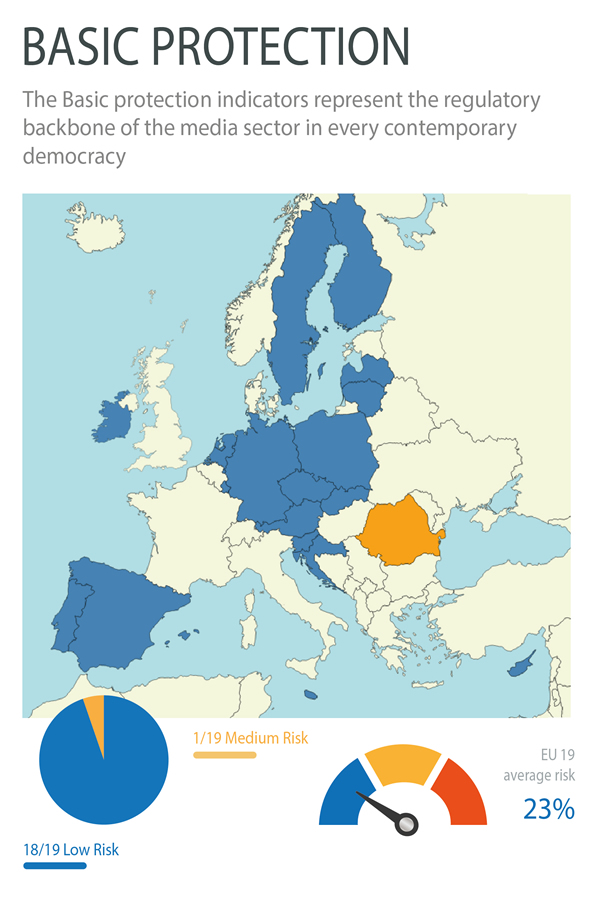
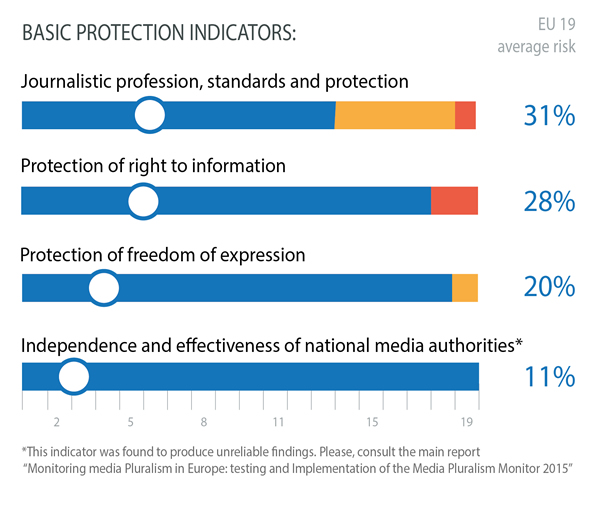
Market Plurality indicators are dealing mostly with media ownership, an economic component that is widely considered essential in the assessment of a level of media pluralism in any given context. The structure of media ownership matters, first of all to assess the influence being exercised by a specific media owner within a single media outlet, both in terms of internal pluralism and of fairness towards the readers and audience. Moreover, the level of concentration of media ownership is important to assess the measure of external pluralism within a given media market. The MPM considers threats to media pluralism coming from the level of transparency and of from the level of concentration of media ownership. The concentration is measured within the same media market (e.g. audio-visual) and across different media markets (cross-media concentration).
Specifically, in the MPM2015 there are three indicators on Market Plurality:
- Transparency of media ownership
- Concentration of media ownership
- Concentration of cross-media ownership
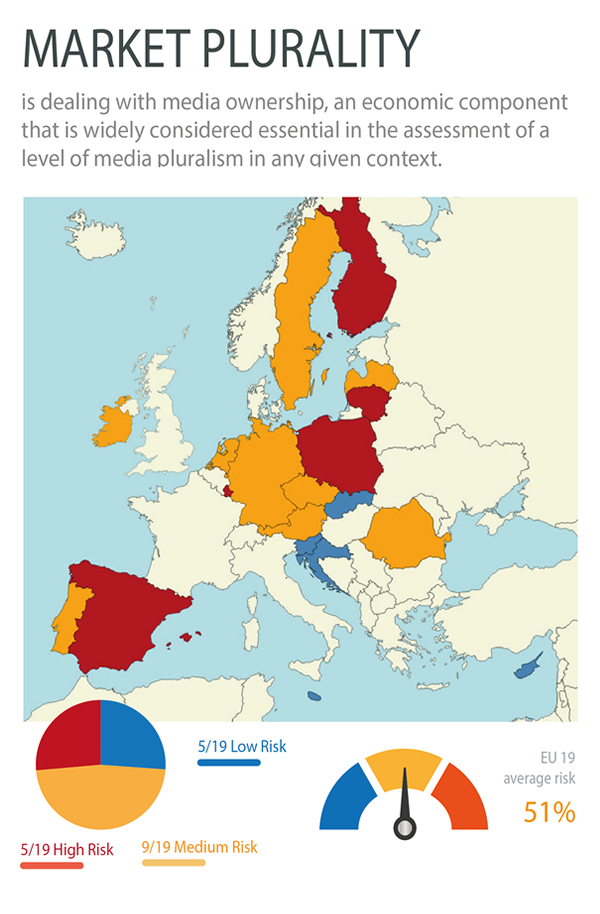
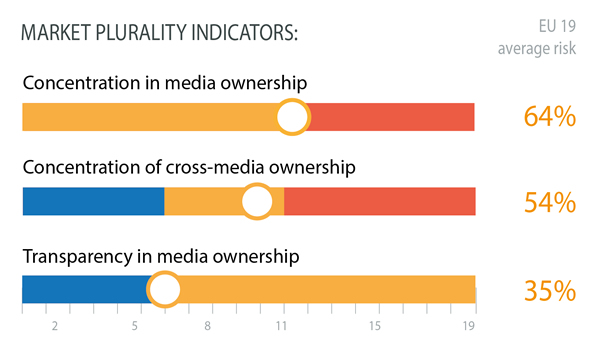
Indicators of Political independence are designed to assess the risks for the political independence of the national media system and its media outlets. They focus on examining the existence and effectiveness of implementation of regulatory safeguards against biased representation of political viewpoints in media, and also the extent of politicisation over media outlets, media distribution networks and news agencies. Moreover, they also aim to assess the influence of the state on the functioning of the media market, with a focus on state advertisement and public service media.
Specifically, there are six indicators of Political independence:
- Political bias in the media
- Politicisation of control over media outlets
- Politicisation of control over media distribution networks
- State advertising
- Independence of PSM governance and funding
- Independence of news agencies


Social inclusiveness indicators are concerned with access to and availability of media for different, and particularly vulnerable, groups of population. They assess regulatory and policy safeguards for access to media by various cultural and social groups, by local communities and by people with disabilities. Moreover, they assess the centralisation of the media system, and the quality of the country’s media literacy policy, as well as the digital media skills of the population.
The Social inclusiveness domain consists of six indicators:
- Access to media for different social and cultural groups, and local communities
- Availability of media platforms for community media
- Access to media for the physically challenged people
- Centralisation of the media system
- Universal coverage of the PSM and the Internet
- Media literacy
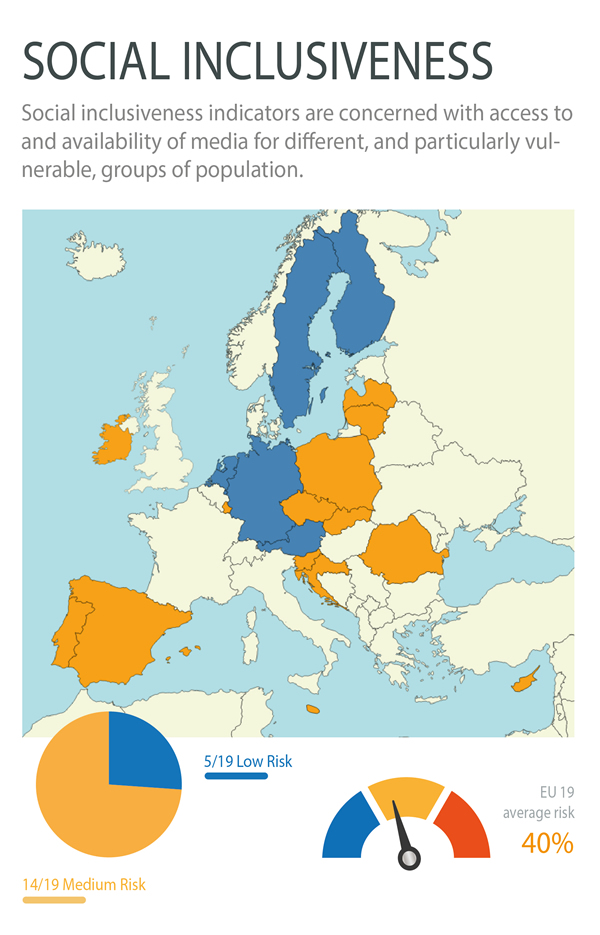

Country Reports
Austria Croatia Cyprus Czech Republic Finland Germany Ireland Latvia Lithuania Luxembourg Malta Netherlands Portugal Poland Romania Spain Sweden Slovenia Slovakia
Key Figures
19 European countries involved – check the country teams
4 Risk Domains monitored
19 Risk Indicators – check the list
60 Risk Sub-Indicators
205 Variables (complete list available for download as part of the Full Report)
109 National Media Experts validating key variables.
Comment from Pier Luigi Parcu, Director of the CMPF
MPM 2015 Presentation
MPM 2015: Country Teams
| Austria | Institute for Comparative Media and Communication Studies (CMC) | Josef Seethaler |
| Croatia | Institute for Development and International Relations (IRMO) | Paško Bilić |
| Cyprus | University of Nicosia | Christophoros Christophorou |
| Czech Republic | Charles University | Vaclav Stetka |
| Finland | University of Jyväskylä | Heikki Kuutti |
| Germany | Hans Bredow Institut | Wolfgang Schulz/Hermann Schroeder |
| Ireland | Dublin City University | Roddy Flynn |
| Latvia | Riga Stradins University | Anda Rozukalne |
| Lithuania | Vytautas Magnus University | Aukse Balcytiene |
| Luxembourg | University of Luxembourg | Raphael Kies |
| Malta | CMPF | |
| Netherlands | University of Antwerp | Miriam van der Burg |
| Poland | University of Krakow | Beata Klimkiewicz |
| Portugal | Universidade Nova de Lisboa | Francisco Rui Nunes Cádima |
| Romania | Median Research Centre&CEU | Marina Popescu |
| Slovakia | School of Communication and Media | Andrej Skolkay |
| Slovenia | University of Ljubljana | Marko Milosavljević |
| Spain | Univ Castilla – La Mancha | Juan Luis Manfredi Sanchez |
| Sweden | University of Gothenburg | Mathias A. Färdigh |
